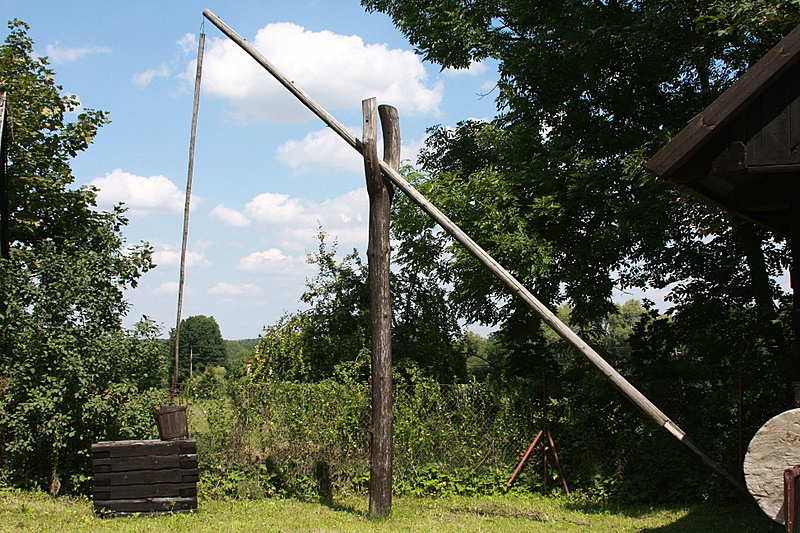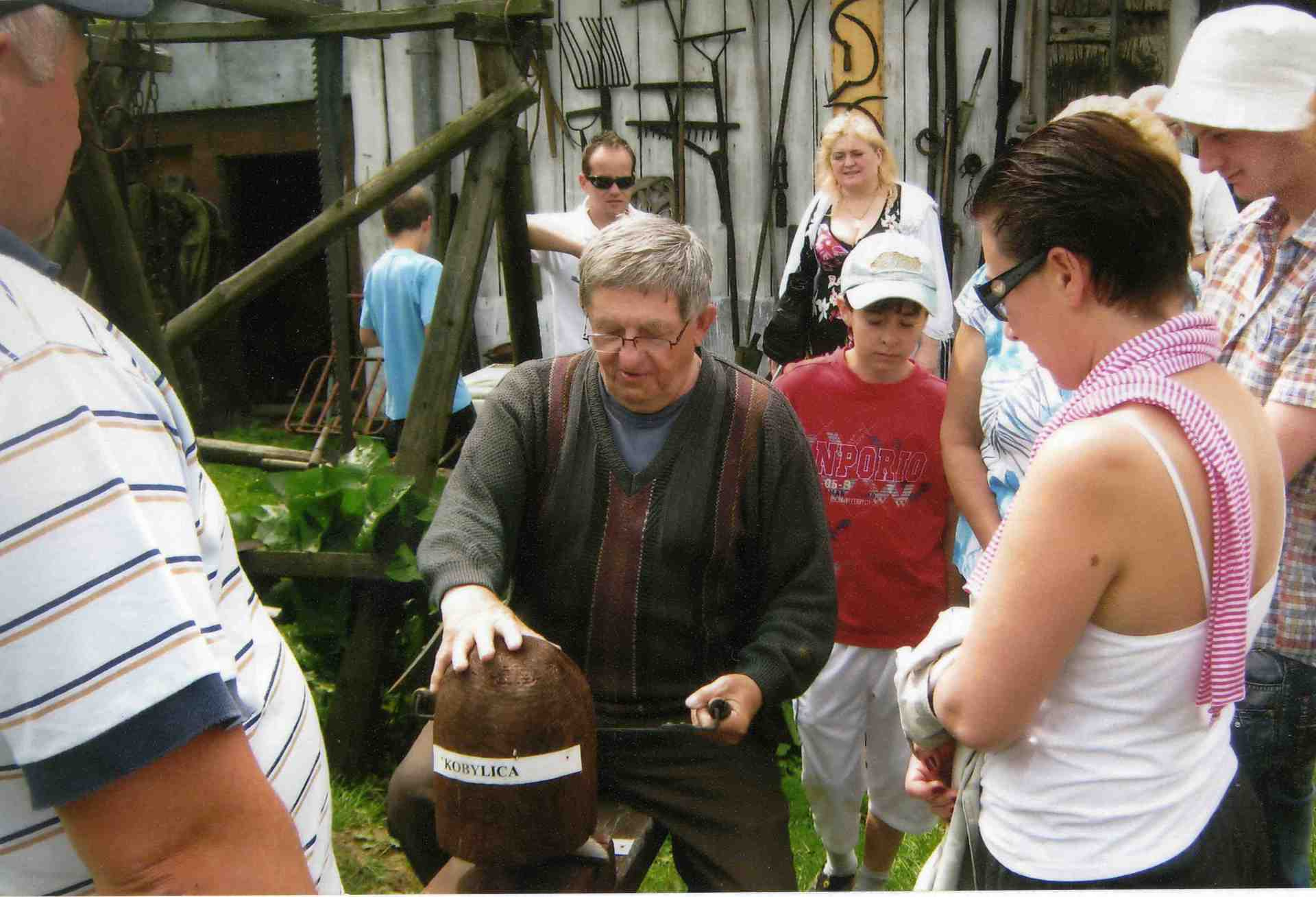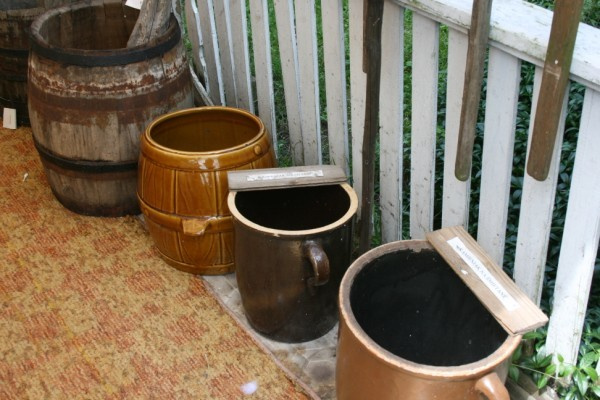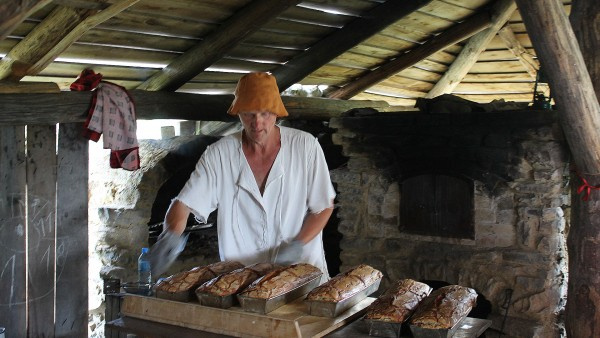Folk tradition-related monuments in the region of Końskie
***Chamber of Tradition by Katarzyna and Euzebiusz Barański
In Fałków, just behind the fence of the parochial church, there is an extraordinary ethnographic and historical exhibition room, whose founders were Katarzyna and Euzebiusz Barański.
In the wooden building of the former organist’s house where organists and parish clerks used to live, the Barański couple collected an impressive number of artefacts which  will surely interest not only experts but also those who would like to know what life looked like in the past.
will surely interest not only experts but also those who would like to know what life looked like in the past.
By the entrance welcomes us a 2-metre figurine of Our Lady of the Rosary, the piece of art by a local artist Józef Zaganiacz. On either side of the porch, on the wall hang information boards from various institutions, usually from the time of Polish People’s Republic (in Polish abbreviated as „PRL”).
In the first room there is a small local art gallery where we can familiarise ourselves with the works of local artists. Our attention can be drawn by a unique Nativity set, in which next to the biblical characters we can also find scythe-bearers and soldiers from the WWII.
In the second room, dedicated to the Fałków history, there arle also objects which were used back in the day. We can find here, for example, a collection of sewing machines, ironing boxes, oil lamps, carbide lamps, photo cameras and radio receivers. The older generation may look with fondness at a school bench with a filled ink bottle, wooden pencil case, the first alphabet book and abacuses.
The next room is the kingdom of linen. One can see here peasnats’ outfits, a lacy baby sleeping bag from white linen, beautifully embroidered pieces of tray cloth, colourful rugs. In the kitchen one will find out everything about bread – starting from planting seeds, over grinding in quern-stones and baking in an oven. There’s also a rich colection of dishes which were used by every housekeeper in the past. There are plenty of pots of various sizes, jugs, bottles, plus butter and milk churns. A long was used as a workshop for a Carpenter, woodworker and shoemaker. Here one can see on one’s own that making a shoe wasn’t so easy after all.
There is also a room devoted to liberating battles which took place in Fałków and its surroundings. We can learn about a very touching story of a young boy, Walerian Wróbel, who was taken by force to work abroad in Germany and sentenced to death for his wish to come back home… After many years, a German lawyer reseraching German crimes, got to the information about the boy. Moved by his story he contrib uted to the revocation of the sentence and one of the streets in Bremmen, where the boy died, was named after Walerian. This is how a boy from Fałków, unknown to anyone before, became a hero.
uted to the revocation of the sentence and one of the streets in Bremmen, where the boy died, was named after Walerian. This is how a boy from Fałków, unknown to anyone before, became a hero.
After leaving the museum, one should also visit the farming outbuildings situated in the backyard. In the barn there are agricultural machines collected, including a horse-pulled reaping machine from 1956, chaff-cutters and machines driven by treadmill. In front of the barn there are bee hives. From the nearby Motkowice, there wes the entire smithy transposed, which belonged to an 80-year old blacksmith called Jan Fatalski.
Practical information: opening hours of the facility: on working days by prior phone agreement; on Sundays at 10-12 and 15-18 . Admission is free of charge. All the relevant infromation can be obtained on +48 600 877 274.
***Private Folklore Museum in Adamów
 The passion of Mr Krawczyk and his wife is gaining popularity. The museum run by them is still developing and visited by local inhabitants, school youth with teachers or caretakers and tourists, including the ones from abroad!
The passion of Mr Krawczyk and his wife is gaining popularity. The museum run by them is still developing and visited by local inhabitants, school youth with teachers or caretakers and tourists, including the ones from abroad!
In the Folklore Museum one will find everyday items, which were used at work, at a farm or by a household by former generations. They include: ironing boxes, quern-stones, wooden pitchforks, old scales, items helpful for winding linen, mangles, cheese presses, flails, collections of sickles to cut crops and also blacksmiths’ ware. In addition, there is a hayrack and even a sleigh.
The oldest artefacts are over 150 years old. The most precious ones include sa cra paintings and censored correspondences from the the war period. All objects are appropriately preserved and described.
cra paintings and censored correspondences from the the war period. All objects are appropriately preserved and described.
The museum is viisted by indiuviduals, tourists hiking nearby, school youth with teachers and even foreigners. Mr Krawczyk talks about past times and no longer used tools in a very interesting way. He does it with lots of commitment, which can be confirmed by visitors’ entries in a commemorative book and a prize awarded in 2012 for cherishing the tradition and promoting the Smyków region as well as for spreading knowledge about the regional history among young generations.
Over the years many exhibitions have been created in the museum. There is one dedicated to Marshall Józef Piłsudski, which was organised on the 100th anniversary of independence regaining. There is also some space assigned to commemorate the pacification of the villages, Adamów and Królewiec. Additionally, one willl find an exhibition displaying the proces of bread baking entitled „ From a seed to a loaf”. The museum owners are affiliated with the Polish nationwide community of the Bastions of Patriotism and Culture.

*** Open-Air Museum (Skansen) in Cisownik
 The museum in Cisownik invites all to a history lesson entitled: „How it was in the countryside back in the day”. The farm is located in the village of Cisownik, in the Smyków commune. The place can be reached from Końskie through Sielpia and Miedzierza.
The museum in Cisownik invites all to a history lesson entitled: „How it was in the countryside back in the day”. The farm is located in the village of Cisownik, in the Smyków commune. The place can be reached from Końskie through Sielpia and Miedzierza.
The best way to tell children about living in the countryside in the past is to do it in nature among tools and devices used a long time ago, in the place where flails still strike and quern-stones scrunch. During 3-hour workshops school students acquire practical knowledge about labour and customs which were observed in the past in the country.
 Every child can check out themselves their manual skills working by former devices: quern-stones, a spinning wheel, a spindle, a mangle, a washboard and a dolly, a steelyard balance, a flail, a churn, a groats mortar or various tools for dressing / scutching flax or different fibers.
Every child can check out themselves their manual skills working by former devices: quern-stones, a spinning wheel, a spindle, a mangle, a washboard and a dolly, a steelyard balance, a flail, a churn, a groats mortar or various tools for dressing / scutching flax or different fibers.
By working with these devices they find out how falx was grown and processed into linen. How grain was sown and threshed and how bread was baked. How small and inconspicuous tools made people’s work and life easier. Students’ labour is crowned by tasting the bread baked in the place in a wood-burning oven.
To make the visit to the museum even more attractive the hosts offer a bonfire. Singing and roasting sausages together is a great suplement to a successful day. There’s also the possibilty of organising workshops outside the museum.
*** Villages: "Heaven" and "Hell"
If you want to find out what it’s like being in heaven or hell when you’re alive, come to the Końskie region. Exactly here hidden in the woods there is "Heaven" and "Hell" (in Polish: Niebo i Piekło), two enchanting villages whose biggest mystery is concealed in their names.
 It’s difficult to define where such extraterrestial names of the villages originate from – perhaps it’s just a whim of their owner or leaseholder. In the past the villages used to be called differently: „Heaven” till 1813 existed as „Babia Góra” (Countrywomen’s Mountain) whereas „Hell” till 1830 was named „Iwasiów”. In economic terms both villages belonged to the Sielpia domain which were purchased in 1825 by the government. They comprised the Sielpia village and grange, villages: Młyny Dziebałtowskie (Dziebałtów Mills, not exisiting any longer), Heaven, Hell, a watermill and a sawmill in Sielpia as well as nearby forests.
It’s difficult to define where such extraterrestial names of the villages originate from – perhaps it’s just a whim of their owner or leaseholder. In the past the villages used to be called differently: „Heaven” till 1813 existed as „Babia Góra” (Countrywomen’s Mountain) whereas „Hell” till 1830 was named „Iwasiów”. In economic terms both villages belonged to the Sielpia domain which were purchased in 1825 by the government. They comprised the Sielpia village and grange, villages: Młyny Dziebałtowskie (Dziebałtów Mills, not exisiting any longer), Heaven, Hell, a watermill and a sawmill in Sielpia as well as nearby forests.
In both settlements there were inns operating which were definitely visited not only by local residents who enjoyed the worldly pleasures offered by them. The number of customers was unfortunately not big enough for inn owners to maintain thier business. In 1826 there were 5 settlers living in „Hell”, together with their families, and one innkeeper. In „Heaven” 7 settlers and one innkeeper – Józef Kuleta. Both forest settlements, besides the innkeepers, were inhabited for a long time by a few peasants’ families, which often complained about their tough lives…
The necessity of serfdom in the remote village of Radoszyce and other chores were a significant burden for the inhabitants, who were not wealthy. As indicated by some references, in 1839 in „Hell” there were only two horses, three oxen, one cow and one pig! The villages developed slowly. In 1907 in „Heaven” there were 111 residents, 12 wooden buildings and 62 tithes (one tithe = 1 ha 9 a). „Hell” had 100 inghabitants, 14 wooden houses and 88 tithes. Currently in „Heaven” there are 90 people living, whereas in „Hell” there are only a few inhabitants registered as permanent ones.
All mentioned above makes „Heaven” and „Hell” a perfect place for relaxation. The villages full of charm, drowned in greenery where one can rest in tranquility from the hustle and bustle of the city and everyday stresses.
The best way to get to „Heaven” and „Hell” is on foot or by bike. Through both villages run the blue walking trail by S. Malanowicz (Kuźniaki - Gruszka - Węgrzyn - Sielpia - Końskie - Stara Kuźnica - Furmanów - Niekłań - Rędocin - Skarżysko Pogorzałe) and the blue cycling trail through Żarnów-Sielpia-Końskie-Antoniów. Two more cycling routes will take us from „Hell” to Sielpia: the red one (around Końskie) and a yellow one (called „Trail of the Places of Power”).
translated by Anna Kania, the employee of the Tourist Information Centre in Końskie




